Molecular mechanism of transcription inhibition by phage T7 gp2 protein
- PMID: 21963987
- PMCID: PMC3217721
- DOI: 10.1016/j.jmb.2011.09.029
Molecular mechanism of transcription inhibition by phage T7 gp2 protein
Abstract
Escherichia coli T7 bacteriophage gp2 protein is a potent inhibitor of host RNA polymerase (RNAP). gp2 inhibits formation of open promoter complex by binding to the β' jaw, an RNAP domain that interacts with downstream promoter DNA. Here, we used an engineered promoter with an optimized sequence to obtain and characterize a specific promoter complex containing RNAP and gp2. In this complex, localized melting of promoter DNA is initiated but does not propagate to include the point of the transcription start. As a result, the complex is transcriptionally inactive. Using a highly sensitive RNAP beacon assay, we performed quantitative real-time measurements of specific binding of the RNAP-gp2 complex to promoter DNA and various promoter fragments. In this way, the effect of gp2 on RNAP interaction with promoters was dissected. As expected, gp2 greatly decreased RNAP affinity to downstream promoter duplex. However, gp2 also inhibited RNAP binding to promoter fragments that lacked downstream promoter DNA that interacts with the β' jaw. The inhibition was caused by gp2-mediated decrease of the RNAP binding affinity to template and non-template strand segments of the transcription bubble downstream of the -10 promoter element. The inhibition of RNAP interactions with single-stranded segments of the transcription bubble by gp2 is a novel effect, which may occur via allosteric mechanism that is set in motion by the gp2 binding to the β' jaw.
Copyright © 2011 Elsevier Ltd. All rights reserved.
Figures
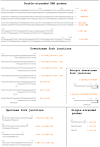
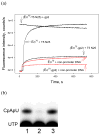
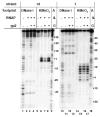
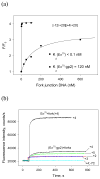
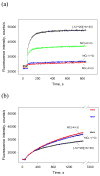


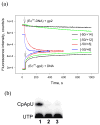
Similar articles
-
Substitutions in the Escherichia coli RNA polymerase inhibitor T7 Gp2 that allow inhibition of transcription when the primary interaction interface between Gp2 and RNA polymerase becomes compromised.Microbiology (Reading). 2012 Nov;158(Pt 11):2753-2764. doi: 10.1099/mic.0.062547-0. Epub 2012 Sep 13. Microbiology (Reading). 2012. PMID: 22977089 Free PMC article.
-
The role of the T7 Gp2 inhibitor of host RNA polymerase in phage development.J Mol Biol. 2010 Sep 10;402(1):118-26. doi: 10.1016/j.jmb.2010.07.012. Epub 2010 Jul 19. J Mol Biol. 2010. PMID: 20650282 Free PMC article.
-
T7 phage protein Gp2 inhibits the Escherichia coli RNA polymerase by antagonizing stable DNA strand separation near the transcription start site.Proc Natl Acad Sci U S A. 2010 Feb 2;107(5):2247-52. doi: 10.1073/pnas.0907908107. Epub 2010 Jan 19. Proc Natl Acad Sci U S A. 2010. PMID: 20133868 Free PMC article.
-
RNA polymerase molecular beacon as tool for studies of RNA polymerase-promoter interactions.Methods. 2015 Sep 15;86:19-26. doi: 10.1016/j.ymeth.2015.04.033. Epub 2015 May 5. Methods. 2015. PMID: 25956222 Free PMC article. Review.
-
Recent studies of T7 RNA polymerase mechanism.FEBS Lett. 1998 Dec 4;440(3):264-7. doi: 10.1016/s0014-5793(98)01484-7. FEBS Lett. 1998. PMID: 9872383 Review.
Cited by
-
E. coli RNA Polymerase Determinants of Open Complex Lifetime and Structure.J Mol Biol. 2015 Jul 31;427(15):2435-2450. doi: 10.1016/j.jmb.2015.05.024. Epub 2015 Jun 6. J Mol Biol. 2015. PMID: 26055538 Free PMC article.
-
Mechanism of transcription initiation and promoter escape by E. coli RNA polymerase.Proc Natl Acad Sci U S A. 2017 Apr 11;114(15):E3032-E3040. doi: 10.1073/pnas.1618675114. Epub 2017 Mar 27. Proc Natl Acad Sci U S A. 2017. PMID: 28348246 Free PMC article.
-
Key roles of the downstream mobile jaw of Escherichia coli RNA polymerase in transcription initiation.Biochemistry. 2012 Nov 27;51(47):9447-59. doi: 10.1021/bi301260u. Epub 2012 Nov 14. Biochemistry. 2012. PMID: 23116321 Free PMC article.
-
Revenge of the phages: defeating bacterial defences.Nat Rev Microbiol. 2013 Oct;11(10):675-87. doi: 10.1038/nrmicro3096. Epub 2013 Aug 27. Nat Rev Microbiol. 2013. PMID: 23979432 Review.
-
Molecular basis of RNA polymerase promoter specificity switch revealed through studies of Thermus bacteriophage transcription regulator.Bacteriophage. 2014 May 29;4:e29399. doi: 10.4161/bact.29399. eCollection 2014. Bacteriophage. 2014. PMID: 25105059 Free PMC article.
References
-
- Nechaev S, Severinov K. Bacteriophage-induced modifications of host RNA polymerase. Annu Rev Microbiol. 2003;57:301–322. - PubMed
-
- Molineux IJ. The T7 group. In: Calendar RL, editor. The Bacteriophages. 2. Oxford University Press; New York: 2005. pp. 277–301.
-
- Hessellbach B, Nakada D. Inactive complex formation between E. coli RNA polymerase and inhibitor protein purified from T7 phage infected cells. Nature. 1975;258:354–357. - PubMed
-
- Nechaev S, Severinov K. Inhibition of Escherichia coli RNA polymerase by bacteriophage T7 gene 2 protein. J Mol Biol. 1999;289:815–826. - PubMed
Publication types
MeSH terms
Substances
Grants and funding
LinkOut - more resources
Full Text Sources
Research Materials

